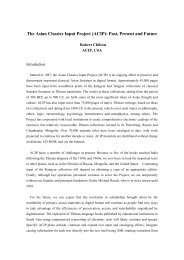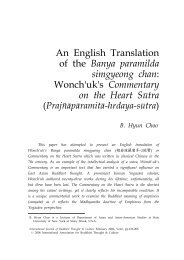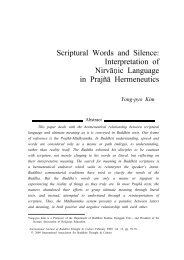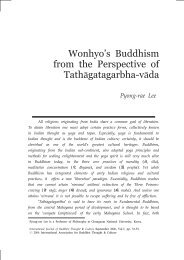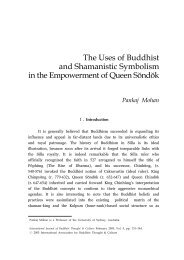Esoteric Buddhism under the KoryÅ in the Light of ... - Buddhism.org
Esoteric Buddhism under the KoryÅ in the Light of ... - Buddhism.org
Esoteric Buddhism under the KoryÅ in the Light of ... - Buddhism.org
You also want an ePaper? Increase the reach of your titles
YUMPU automatically turns print PDFs into web optimized ePapers that Google loves.
International Journal <strong>of</strong> Buddhist Thought & Culture 65<br />
rituals, <strong>in</strong> particular those connected with <strong>Esoteric</strong> <strong>Buddhism</strong> <strong>under</strong> <strong>the</strong><br />
Koryŏ would appear to have surpassed those performed at <strong>the</strong> courts <strong>of</strong><br />
both Heian and Kamakura Japan by far. That is <strong>of</strong> course provided that<br />
<strong>the</strong> sources can be trusted. This <strong>in</strong>dicates that <strong>the</strong> connection between<br />
<strong>the</strong> Koryŏ rulers and <strong>Buddhism</strong> was not only very close, but that <strong>the</strong><br />
demarcation between secular and religious power was highly oblique<br />
<strong>in</strong>deed. In any case <strong>the</strong> relationship between <strong>the</strong> rul<strong>in</strong>g house and<br />
<strong>Buddhism</strong> was <strong>in</strong>timate to <strong>the</strong> po<strong>in</strong>t <strong>of</strong> be<strong>in</strong>g <strong>in</strong>terdependent. In o<strong>the</strong>r<br />
words, what was good for <strong>the</strong> Koryŏ k<strong>in</strong>gs and <strong>the</strong> realm was also good<br />
for <strong>Buddhism</strong>. Here one may make a direct comparison between <strong>the</strong><br />
manner <strong>in</strong> which medieval Christianity <strong>in</strong> Europe supported a given<br />
secular power and vice-versa. 15 It is when seen from this perspective<br />
that <strong>the</strong> concept <strong>of</strong> “<strong>Buddhism</strong> as protector <strong>of</strong> <strong>the</strong> nation” should be<br />
seen, while bear<strong>in</strong>g <strong>in</strong> m<strong>in</strong>d that no idea match<strong>in</strong>g that <strong>of</strong> <strong>the</strong> modern<br />
“nation-state” existed <strong>under</strong> <strong>the</strong> Koryŏ. The fortunes <strong>of</strong> <strong>the</strong> rul<strong>in</strong>g<br />
family, by extension <strong>the</strong> Koryŏ k<strong>in</strong>gdom and <strong>Buddhism</strong> were essentially<br />
one and <strong>the</strong> same th<strong>in</strong>g.<br />
The Bestowal <strong>of</strong> <strong>the</strong> Bodhisattva Precepts (Kor. posal kye 菩 薩 戒 )<br />
on <strong>the</strong> Koryŏ K<strong>in</strong>gs was an important ritual <strong>in</strong> <strong>the</strong> royal cult, which<br />
foremostly served to cement <strong>the</strong> relationship between <strong>the</strong> Koryŏ rulers<br />
and <strong>Buddhism</strong>. Almost all <strong>the</strong> Koryŏ k<strong>in</strong>gs are recorded as hav<strong>in</strong>g<br />
received <strong>the</strong>se precepts and o<strong>the</strong>r forms <strong>of</strong> <strong>in</strong>itiation at least once<br />
dur<strong>in</strong>g <strong>the</strong>ir respective reigns, while <strong>the</strong> more devout rulers had <strong>the</strong>se<br />
rites carried out several times dur<strong>in</strong>g <strong>the</strong>ir respective reigns. As were<br />
<strong>the</strong> cases <strong>in</strong> <strong>the</strong> o<strong>the</strong>r East Asian countries, <strong>under</strong> <strong>the</strong> Koryŏ <strong>the</strong><br />
Bodhisattva Precepts were adm<strong>in</strong>istered accord<strong>in</strong>g to <strong>the</strong> Brahm2j2la s^tra<br />
(Fanwang j<strong>in</strong>g 梵 網 經 ). 16 Normally this ritual would take place dur<strong>in</strong>g<br />
<strong>the</strong> first year <strong>of</strong> a new ruler’s ascension to <strong>the</strong> throne, but could <strong>in</strong><br />
15 In Korea Hŏ Hŭngsik has devoted considerable attention to this issue from <strong>the</strong> perspective <strong>of</strong><br />
Buddhist social history and has made a conv<strong>in</strong>c<strong>in</strong>g comparison with <strong>the</strong> relationship between<br />
<strong>the</strong> secular rulers and <strong>the</strong> Catholic church <strong>in</strong> medieval Europe. See Hŏ (1994).<br />
16 T.24, No.1484. This apocryphal scripture is still used today <strong>in</strong> Korea as <strong>the</strong> basic text for <strong>the</strong><br />
bestowal <strong>of</strong> <strong>the</strong> bodhisattva precepts for both monks and laity. See Buswell (1992). For a study<br />
<strong>of</strong> <strong>the</strong> Fanwang j<strong>in</strong>g <strong>in</strong> <strong>the</strong> Japanese Buddhist context, see Groner (1990).



